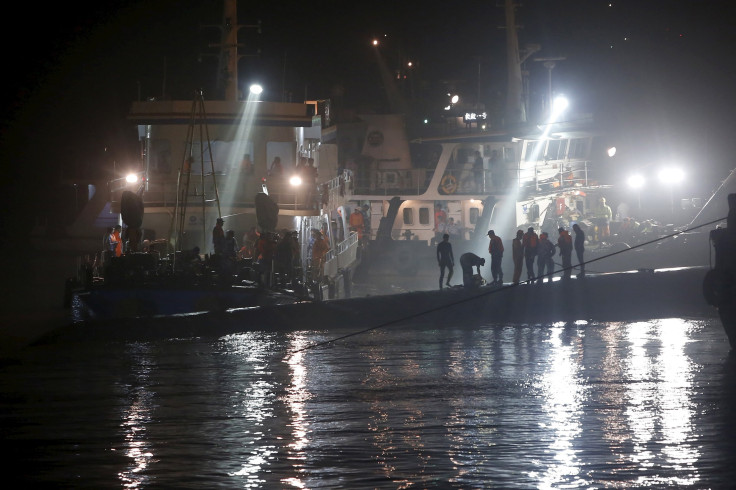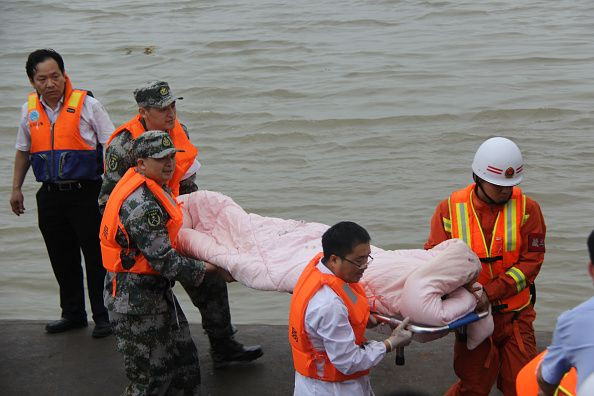China's Media Coverage Of Yangtze Ship Disaster Highlights Public Need For Information, And Official Desire To Control

SHANGHAI -- From rolling television news reports, to limits on the sources local media are allowed to use, China’s reporting of the Yangtze ship disaster shows both how much more open the country has become since the arrival of the Internet era -- and also how concerned the authorities remain about controlling the flow of information.
On Tuesday morning, just hours after the accident, the news network of both national broadcaster China Central Television (CCTV) and, for a few hours at least, Shanghai’s national satellite channel Dragon TV, began providing rolling coverage of the situation -- with live updates from reporters at or near the river bank close to where the cruise ship, the Eastern Star, capsized with 458 people on board. Dragon TV also broadcast reports of shocked relatives arriving at the dock in Nanjing, where the boat sailed from, and at the offices of the travel agency in Shanghai that arranged the tour for the 406 mainly elderly passengers.
As the day went on, both channels also hosted guest experts who debated the questions that many were asking online: how and why the boat might have capsized, why it did not send out a distress signal -- and why the captain and chief engineer (who were reported to have been detained by police) were among the few confirmed survivors.
The rolling coverage provided some uplifting moments, notably when two survivors were rescued by frogmen on Tuesday afternoon -- but by Wednesday morning, with no obvious sign of any of the more than 400 missing passengers still being alive, CCTV’s live coverage was showing a partially covered dead body laid out on the hull of the upturned boat. China’s Premier Li Keqiang and other officials, who had arrived at the scene on Tuesday, were also shown bowing in respect to two bodies on the deck of another boat.
News Coverage In The Internet Age
It was certainly a far cry from the coverage of some previous disasters in China. In 1998, when floods on the Yangtze killed more than 3,500 people, state television coverage focused almost entirely on the heroism of soldiers and others fighting against the floods, with barely a victim to be seen. In the Internet age, though, such one-sided reporting has become harder to maintain, as Web users have access to more sources of information and tend to be more critical in their attitudes toward blatant propaganda.
China’s leadership, which has recently been keen to show how close it is to the people, is also likely to have been mindful of past cases, such as the serious floods in Beijing in 2012, when officials were criticized online for their slow response, and, above all, the crash of a high-speed train near the eastern city of Wenzhou in 2011, in which 40 people died.

On the latter occasion, officials were criticized both for being too slow to release information about what had happened -- news of the crash was first released by witnesses on social media -- and then for being too quick to abandon hope of finding anyone alive: They infamously buried some of the crashed train’s carriages, in an attempt to clean up the scene before a visit by then Premier Wen Jiabao -- and a small child was found alive in the wreckage after officials had ordered the search for survivors to be called off.
In the case of the latest disaster, no-one could accuse the authorities of giving up too early: on Wednesday morning, as more bodies were pulled out of the boat, a TV host expressed hope that the frogmen would “bring us more good news,” and news reports highlighted preparations at local hospitals to receive more survivors.
There were also interviews with divers discussing their work, and with other officials involved in the search-and-rescue operation, which focused more on practical details than on the type of slogans that would have been likely in the past.
Government Pushes The Positive
However, the attempts to retain a generally upbeat tone were a reminder of the other aspect of media coverage: the authorities’ attempts to set the tone, or, as they would put it, to “guide public opinion.” Several sources reported that Chinese journalists had been encouraged to accentuate the positive. And the focus on the journey, arrival and activities of Premier Li on Tuesday was also clearly designed to get the leadership’s message across: not only did China’s top leaders care, but they were hands-on, as demonstrated by shots of the premier wagging his finger at officials on his plane en route to the Yangtze, and visiting survivors in a hospital. Li’s presence, along with comments on the incident from President Xi Jinping, also dominated the headlines of many newspapers and websites on Wednesday.
The positive message was also reinforced by headlines like that running on the official Xinhua News Agency’s website on Wednesday afternoon -- some 40 hours after the ship capsized -- which announced: “Latest news: fourteen people already rescued,” though no-one had been rescued for almost 24 hours. Images of a woman being rescued on Tuesday were also repeated on CCTV throughout the day on Wednesday.

In a further sign of the authorities’ desire to control the agenda, regional news outlets were reported to have been instructed to use content from CCTV and Xinhua, rather than sending their own reporters to the scene of the accident. The directive is in line with recent efforts by the leadership to boost the online influence of these “mainstream” state media outlets, as opposed to more populist websites and more unruly regional newspapers, like those from the southern city of Guangzhou -- amid official fears that Internet users are being overly influenced by Western ideas, and have a tendency to express vulgar, or at least critical views. (Last month the government was reported to have issued a list of approved media sources, which did not feature Guangzhou’s most popular papers.).
Still, as in the case of the Sichuan earthquake in 2008, some local media appear to have gone ahead and sent reporters to the scene anyway -- though some were reported to have later been sent back. Shanghai news website The Paper, which is owned by the city’s official newspaper group, but is seeking to attract younger readers, carried pictures from its own reporter at the scene, while Shanghai TV also initially sent reporters to the river.
And several papers carried reports that seemed to be out of step with the official limits: While Shanghai’s media avoided reporting on Tuesday’s reported dispute between relatives of those on board the boat, who were demanding more information, and government officials, they did focus on the concerns of the family members, including their demands to be allowed to visit the site of the accident. (The Shanghai authorities originally turned down this request, before changing their mind on Wednesday afternoon, according to The Paper.)
The Paper also quoted reports that a tour guide on another boat, which left Nanjing at the same time as the doomed cruise ship, had said that the ship seemed to be in a hurry to get to tourist sites on the river; she said that her own boat’s captain decided that the weather did not look promising on Monday evening, and therefore pulled into port, while the Eastern Star kept going.
Several other Shanghai media followed up on this topic, with Shanghai TV interviewing experts who questioned the captain’s decision, and also quoting a local maritime official who said the city’s authorities would not allow ships to sail in winds as high as those on the Yangtze on Monday evening.
The Yangtze Evening News, a newspaper based in Nanjing, the home town of many of those on the boat, also questioned whether recent renovations on the cruise ship’s cabins by its owner, a government-owned shipping company, might have altered its center of gravity. And other reports also noted that Chinese journalists had expressed frustration that they had not been allowed to ask questions at a news conference given by China’s Transport Minister on Tuesday evening.
Shades Of Black
And in a reminder of a tradition that began as disobedience to censors following the 2011 train crash, when positive coverage was demanded, several newspapers, including the Yangtze Evening News, Shanghai’s Oriental Morning Post, and the Shanghai Morning Post, all put a black border around their front page stories, to express mourning for the victims. (Although the latter arguably slightly undermined the seriousness of its story by running an upside-down picture of the cruise ship at the top of its front page.)
Overall, the authorities appear to have come in for less criticism on social media on this occasion than in the case of some of the other disasters in recent years -- with many citizens apparently accepting that what happened was basically a tragic accident -- and some setting up online mourning sites for the boat’s missing passengers.
However, some references to the ship were reportedly deleted from China’s social media sites. And state media did not directly report questions posted by some Internet users asking why the authorities had not cut further into the ship’s hull on Tuesday, the day after the accident.
However, in an apparent response to such questions, the official People’s Daily newspaper was reported to have issued a list of answers to citizens’ questions about the handling of the disaster -- including this particular topic. It was a further example of the ongoing push and pull between official attempts to rein in the media -- and the government’s awareness that, after a decade of growing openness online, it cannot completely ignore the concerns and questions of its citizens.
© Copyright IBTimes 2025. All rights reserved.






















